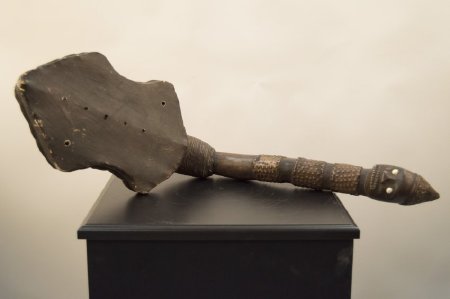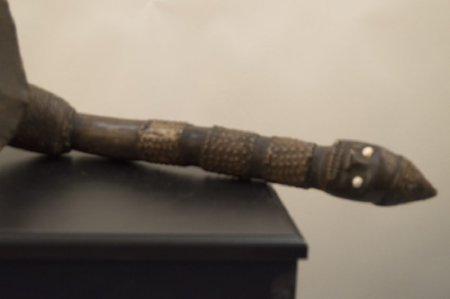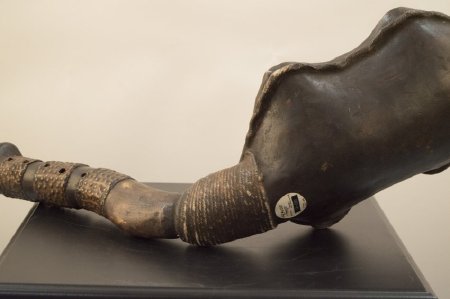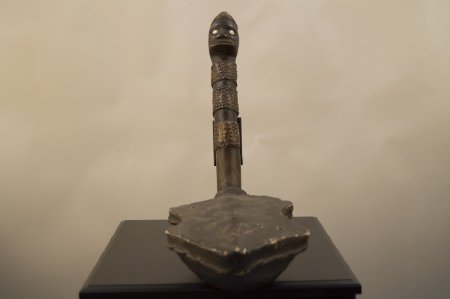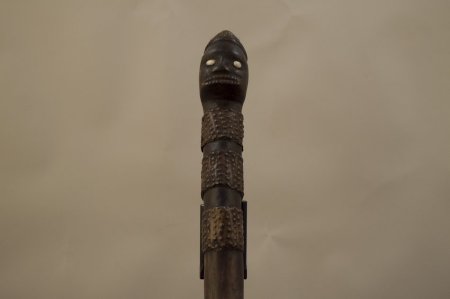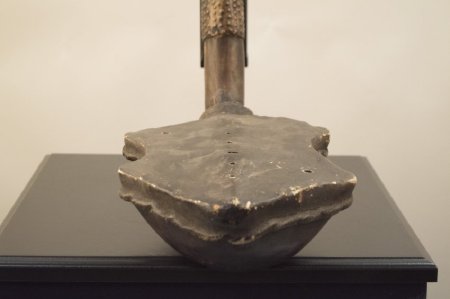Title:
Mangbetu Style Anthropomorphic Harp
Object Name:
Harp, Mangbetu Style
Other Name:
Harp, Mangbetu Style, Anthropomorphic
Place of Origin:
Mangbetu Style, Democratic Republic of Congo, Africa
Provenance:
Aboriginal Indigenous Art.
H = 26"
W = 8"
D = 11"
Mangbetu art, famous for its realism, is a court art.Wooden figures are believed to be ancestral portraits. It was developed particularly in terms of everyday objects under the impetus of the clan chiefs who wanted to show off their power and wealth. Royal celebrations, which took place in large vaulted sheds, were opportunities for exhibiting objects of luxury and refinement: pipes, palm wine jars featuring sculpted figures and heads, tree—bark boxes with covers decorated with heads, harps and trumpets played by wandering musicians, ornamental horns in worked ivory. Decorated thrones and knives were also part of the royal regalia. The Mangbetu tradition of compressing an infant's head with raffia in order to obtain an elongated skull is apparent in the statues. The elongation is further enhanced by a high coiffure finishing in a cup—like finial.
H = 26"
W = 8"
D = 11"
Mangbetu art, famous for its realism, is a court art.Wooden figures are believed to be ancestral portraits. It was developed particularly in terms of everyday objects under the impetus of the clan chiefs who wanted to show off their power and wealth. Royal celebrations, which took place in large vaulted sheds, were opportunities for exhibiting objects of luxury and refinement: pipes, palm wine jars featuring sculpted figures and heads, tree—bark boxes with covers decorated with heads, harps and trumpets played by wandering musicians, ornamental horns in worked ivory. Decorated thrones and knives were also part of the royal regalia. The Mangbetu tradition of compressing an infant's head with raffia in order to obtain an elongated skull is apparent in the statues. The elongation is further enhanced by a high coiffure finishing in a cup—like finial.
Description:
Wooden harp instrument, carved in traditional guitar—like shape, with a smooth black rounded back and flat black top or belly, covered with skin. Long cylindrical neck or bridge, with three sections of pock marked metal encircling neck, ending with an anthropomorphic face. White marble—like eyes, with metal hat adorning top of head. None of the strings or tuning pegs are still present with this piece.
Collection:
Guy Mace Collection, (Turblex Company)
Material:
Wood W/Skin and Metal
Used:
Ritually Used
Technique:
Carving / Tanning / Metal Working
Owned:
Art Department, Missouri Southern State University
Accession#:
2015.2.31
